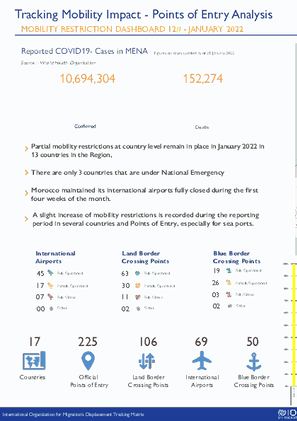-
Countries
-
Data and Analysis
-
Special Focus
-
Crisis Responses
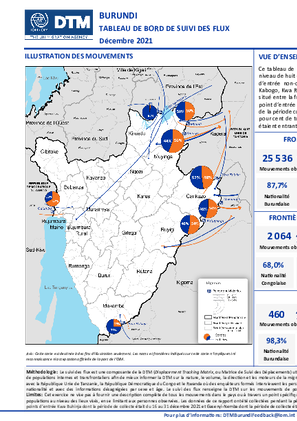
Contact
DTMBurundi@iom.int
Language
French
Location
Burundi
Period Covered
Dec 01 2021
Dec 31 2021
Activity
- Flow Monitoring Survey
- Flow Monitoring
Ce tableau de bord fournit une analyse des tendances de la mobilité des populations observées au niveau de huit points de suivi des flux (Flow Monitoring Points, FMP), six établis sur des points d’entrée non-officiels établis entre la frontière du Burundi et la République Unie de Tanzanie à Kabogo, Kwa Rutuku, Mbundi, Kabuyenge, Mukambati et Kwa Buhinja; un point d’entrée officiel situé entre la frontière du Burundi et de la République Démocratique du Congo à Gatumba et un point d’entrée officiel situé entre la frontière du Burundi et du Rwanda à Gasenyi-Nemba. Au cours de la période considérée, un total de 28 060 mouvements ont été observés à ces points. Environ 51,9 pour cent de tous les mouvements au niveau des trois frontières étaient sortants et 48,1 pour cent étaient entrants.
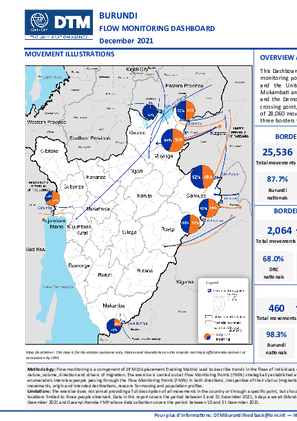
Contact
DTMBurundi@iom.int
Language
English
Location
Burundi
Period Covered
Dec 01 2021
Dec 31 2021
Activity
- Flow Monitoring Survey
- Flow Monitoring
This Dashboard provides an analysis of the trends in population mobility observed at eight flow monitoring points (FMPs), six established at unofficial border crossing points between Burundi and the United Republic of Tanzania border at Kabogo, Kwa Rutuku, Mbundi, Kabuyenge, Mukambati and Kwa Buhinja; one established at official border crossing point, between Burundi
and the Democratic Republic of the Congo at Gatumba and one established at official border crossing point, between Burundi and Rwanda at Gasenyi-Nemba. Over the reporting period, a total of 28,060 movements were observed at these points. About 51.9 per cent of all movements at the three borders were outgoing and 48.1 per cent were incoming.
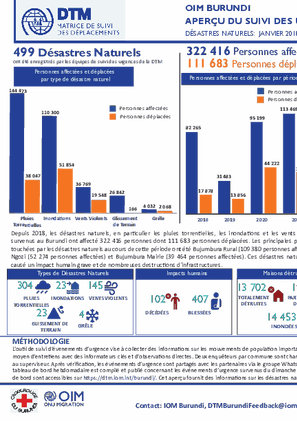
Contact
DTM Burundi, DTMBurundi@iom.int
Language
French
Location
Burundi
Period Covered
Jan 01 2018
Dec 31 2021
Activity
- Event Tracking
- Mobility Tracking
Depuis 2018, les désastres naturels, en particulier les pluies torrentielles, les inondations et les vents violents survenus au Burundi ont affecté 322 416 personnes dont 111 683 personnes déplacées. Les principales provinces touchées par les désastres naturels au cours de cette période ont été Bujumbura Rural (109 380 personnes affectées), Ngozi (52 274 personnes affectées) et Bujumbura Mairie (39 464 personnes affectées). Ces désastres naturels ont causé un impact humain grave et de nombreuses destructions d’infrastructures.
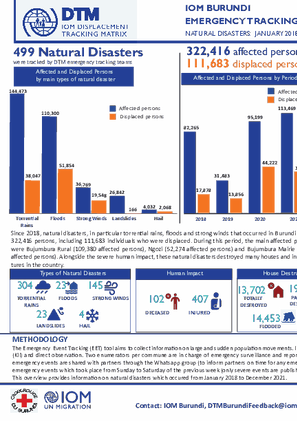
Contact
DTM Burundi, DTMBurundi@iom.int
Language
English
Location
Burundi
Period Covered
Jan 01 2018
Dec 31 2021
Activity
- Event Tracking
- Mobility Tracking
Since 2018, natural disasters, in particular torrential rains, floods and strong winds that occurred in Burundi affected
322,416 persons, including 111,683 individuals who were displaced. During this period, the main affected provinces
were Bujumbura Rural (109,380 affected persons), Ngozi (52,274 affected persons) and Bujumbura Mairie (39,464
affected persons). Alongside the severe human impact, these natural disasters destroyed many houses and infrastructures
in the country.
This Middle East and North Africa (MENA) report summarizes mobility restrictions at airports, land, and blue border crossing points resulting from the mitigation measures implemented in response to the COVID-19 pandemic.
Contact
DTM Yemen, iomyemendtm@iom.int
Location
Yemen
Activity
- Event Tracking
- Mobility Tracking
Period Covered
Jan 23 2022 -Jan 29 2022
From 01 January 2022 to 29 January 2022, IOM Yemen DTM estimates that 2,190 households (HH) (13,140 Individuals) have experienced displacement at least once.
Since the beginning of 2022, DTM also identified 4 displaced households who left their locations of displacement and either moved back to their place of origin or another location.
Between 23 and 29 January 2022, IOM Yemen DTM tracked 462 households (2,772 individuals) displaced at least once. The top three governorates and districts where people moved into/within are:
• Shabwah (170 HH) – Ataq (122 HH), Bayhan (30 HH), Ayn (18 HH) districts. Most displacements in the governorate were internal.
• Al Hodeidah (141 HH) – Hays (114 HH), Al Khukhah (27 HH) districts. Most displacements in the governorate originated from Al Hodeidah and Taiz.
• Marib (76 HH) – Marib City (49 HH), Marib (27 HH) districts. Most displacements in the governorate originated from Marib and Shabwah.
Most displacements resulted from the increased conflict in the following governorates and districts.
• Shabwah (159 HH) – Ayn (159 HH) district.
• Al Hodeidah (99 HH) – Hays (85 HH), Al Hawak (4 HH), Al Khukhah (3 HH) districts.
• Taiz (93 HH) – Maqbanah (61 HH), Jabal Habashi (18 HH), Sabir Al Mawadim (4 HH) districts.
Population Groups
Survey Methodology
Unit of Analysis Or Observation
Type of Survey or Assessment
Keywords
Geographical Scope
Administrative boundaries with available data
The current dataset covers the following administrative boundaries
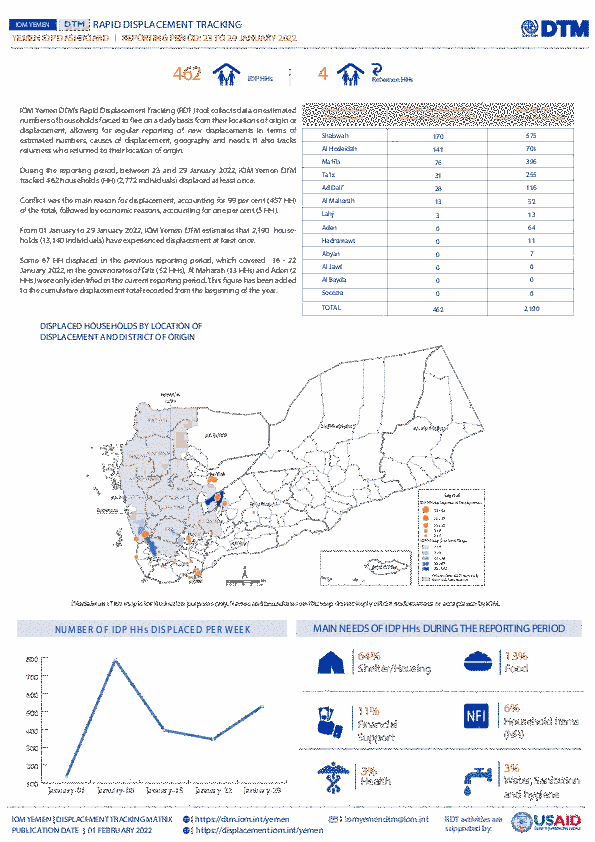
Contact
DTM Yemen, iomyemendtm@iom.int
Language
English
Location
Yemen
Period Covered
Jan 23 2022
Jan 29 2022
Activity
- Rapid Emergency Registration
- Mobility Tracking
IOM Yemen DTM’s Rapid Displacement Tracking (RDT) tool collects data on estimated numbers of households forced to flee on a daily basis from their locations of origin or displacement, allowing for regular reporting of new displacements in terms of estimated numbers, geography, and needs. It also tracks Returnees who returned to their location of origin.
From 01 January 2022 to 29 January 2022, IOM Yemen DTM estimates that 2,190 households (HH) (13,140 Individuals) have experienced displacement at least once.
Since the beginning of 2022, DTM also identified 4 displaced households who left their locations of displacement and either moved back to their place of origin or another location.
Between 23 and 29 January 2022, IOM Yemen DTM tracked 462 households (2,772 individuals) displaced at least once. The top three governorates and districts where people moved into/within are:
- Shabwah (170 HH) – Ataq (122 HH), Bayhan (30 HH), Ayn (18 HH) districts. Most displacements in the governorate were internal.
- Al Hodeidah (141 HH) – Hays (114 HH), Al Khukhah (27 HH) districts. Most displacements in the governorate originated from Al Hodeidah and Taiz.
- Marib (76 HH) – Marib City (49 HH), Marib (27 HH) districts. Most displacements in the governorate originated from Marib and Shabwah.
Most displacements resulted from the increased conflict in the following governorates and districts.
- Shabwah (159 HH) – Ayn (159 HH) district.
- Al Hodeidah (99 HH) – Hays (85 HH), Al Hawak (4 HH), Al Khukhah (3 HH) districts.
- Taiz (93 HH) – Maqbanah (61 HH), Jabal Habashi (18 HH), Sabir Al Mawadim (4 HH) districts.
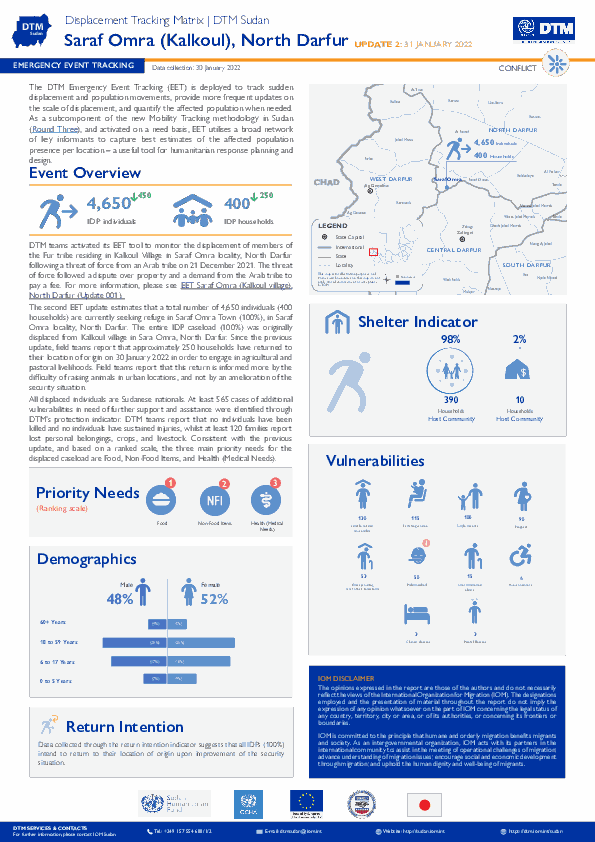
Contact
DTM Sudan; dtmsudan@iom.int
Language
English
Location
Sudan
Snapshot Date
Jan 30 2022
Activity
- Event Tracking
- Mobility Tracking
The DTM Emergency Event Tracking (EET) is deployed to track sudden displacement and population movements, provide more frequent updates on the scale of displacement, and quantify the affected population when needed. As a subcomponent of the new Mobility Tracking methodology in Sudan (Round Three), and activated on a need basis, EET utilises a broad network of key informants to capture best estimates of the affected population presence per location – a useful tool for humanitarian response planning and design.

Contact
IOM Iran (Islamic Republic of) dtmremapsupport@iom.int
Language
Persian
Location
Iran (Islamic Republic of)
Period Covered
Sep 01 2021
Oct 31 2021
Activity
- Points of Entry (PoE)
March 2020 - October 2021
شیوع همه گیری کووید 19 در ابتدای سال 2020، بر پویایی جمعیتی در سطح جهانی و منطقه ای و همینطور در جمهوری اسلامی ایران تأثیرگذار بوده است که این تأثیر بیشتر به شکل ایجاد محدودیت ها یا تغییرات ناگهانی در مسافرت ها خود را نشان داده است.
به منظور درک بهتر چگونگی تأثیر همه گیری بر پویایی جمعیتی در سطح جهانی، سازمان بین المللی مهاجرت ابزاری برخط (آنلاین) و پایگاه داده ای ایجاد نموده است تا بتوان گذرگاه های ورودی، خروجی و گذار مانند فرودگاه ها، مرزهای زمینی و دریایی را که محدودیت های آمد و شد، اقدامات آمادگی و پاسخ به کووید 19 در آنجا صورت میگیرد، را به تصویر کشید. به منظور کمک به این تلاش ها، سازمان بین المللی مهاجرت در طول 20 ماه گذشته تلاش نموده است تا داده های مرتبط را از منابع رسمی دولتی جمع آوری نموده و در قالب این گزارش برای درک بهتر تأثیرات کووید 19 بر پویایی جمعیتی به نمایش در آورد. بر اساس داده های جمع آوری شده می توان تحلیل های جامعی از روندهای پویایی و محدودیت های ناشی از همه گیری داشت تا بتوان به صورت اثربخش تری برای مهار تأثیرات کووید 19 برنامه ریزی نمود.
در طول سپتامبر و اکتبر 2021 ، سازمان بین المللی مهاجرت موفق گردید تا 93 گذرگاه و وضعیت آن ها را نمایش دهد. رایج ترین نوع گذرگاه ها شامل 47 فرودگاه، 30 گذرگاه زمینی و 16 گذرگاه دریایی می باشد. شایان ذکر است که مبادی گذار در این تحلیل لحاظ نشده اند. در پایان ماه اکتبر، 46 گذرگاه کاملا عملیاتی٬ 43 گذرگاه نیمه عملیاتی، 1 گذرگاه به طور کامل بسته بودند.

Contact
iomiranmedia@iom.int
Language
English
Location
Iran (Islamic Republic of)
Period Covered
Sep 01 2021
Oct 31 2021
Activity
- Points of Entry (PoE)
The outbreak of the COVID-19 pandemic at the beginning of 2020 has affected global and regional mobility, including mobility in Iran (Islamic Republic of), through various travel disruptions and restrictions.
To better understand how the pandemic affects global mobility, the International Organization for Migration (IOM) developed an online tool and database to register points of entry, exit and transit - such as airports, land and blue border crossing points - where mobility restrictions and preparedness and response measures are in place. To support these efforts, over a period of 20 months, the Displacement Tracking Matrix Regional Evidence for Migration Analysis and Policy (DTM REMAP) team in Iran (Islamic Republic of) mapped and gathered data on the locations, statuses and restrictions at Points of Entry (PoE) in the country. The information gathered allows more in-depth analysis to uncover specific trends related to the locations, statuses and restrictions of PoEs in Iran (Islamic Republic of).
Between September and October 2021, the DTM REMAP team in Iran (Islamic Republic of) assessed 93 PoEs. The most common type of PoE reported was airports (47), followed by land borders (30) and blue borders (16). Internal transit points are not taken into account in this snapshot. At the end of October, 46 POEs were fully operational, 43 were partially operational and 1 of the PoEs was fully closed.
After 20 months of suspension, foreign nationals have been able to apply for tourist visas beginning from 27th October 2021. Land borders, like air borders, are now accessible for Iranian and foreign nationals. All passengers need a vaccination card (full two-doses) and a negative COVID-19 test certificate valid for 96 hours.
